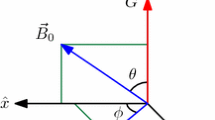Abstract
Nuclear magnetic resonance (NMR) is a successful method for experimental implementation of quantum information processing. Most of the successful NMR quantum processors are small molecules in liquid state. In this case each spin half particle represents a qubit. Another approach is the usage of higher spin particles as multi qubit systems. We present the first solid state virtual 2-Qubit system, represented by the spin-3/2 nucleus 23Na in a NaNO3 single crystal. For this system we show how to create the pseudo pure states and we derive a set of propagators and logic gates corresponding to the selective excitation of single quantum transitions. With this set, the preparation of an “entangled” state is experimentally verified by state tomography, adjusted to the spin-3/2 system.
PACS: 0.367Lx; 76.60-k
Similar content being viewed by others
REFERENCES
D. Deutsch, Proc. R. Soc. Lond. A 400, 97 (1985).
P. W. Shor, Proceedings, 35th Annual Symposium on Foundations of Computer Science (1994).
L. K. Grover, Phys. Rev. Lett. 79, 325 (1997).
A. M. Turing, Proc. Lond. Math. Soc. 42, 230 (1936).
Y. S. Weinstein, M. A. Pravia, E. M. Fortunato, S. Lloyd, and D. G. Cory, Phys. Rev. Lett. 86, 1889 (2001).
D. G. Cory, R. Laflamme, E. Knill, L. Viola, T. F. Havel, N. Boulant, G. Boutis, E. Fortunato, S. Lloyd, R. Martinez, C. Negrevergne, M. Pravia, Y. Sharf, G. Teklemariam, Y. S. Weinstein, and W. H. Zurek, Fortschr. Phys. 48, 875 (2000).
A. R. Kessel and V. L. Ermakov, Proc. of SPIE, 4061, 68 (2000).
A. R. Kessel and V. L. Ermakov, JETP Lett. 71, 307 (2000).
A. Kumar, K. V. Ramanathan, N. Sinha, and T. S. Mahesh, J. Chem. Phys. 114, 4415 (2001).
A. K. Khitrin and B. M. Fung, J. Chem. Phys. 112, 6963 (2000).
R. V. Pound, Phys. Rev. 79, 685 (1950).
R. R. Ernst, G. Bodenhausen, and A. Wokaun, Principles of Nuclear Magnetic Resonance in One and Two Dimensions (Oxford Science Publications, Oxford, 1987).
M. Munowitz, Coherence and NMR (John Wiley & Sons: Chichester, 1988).
M. N. Nielsen and I. L. Chuang, Quantum Computation and Quantum Information (Cambridge University Press, Cambridge, 2000).
A. Barenco, C. H. Bennett, R. Cleve, D. P. DiVincenzo, N. Margolus, P. Shor, T. Sleator, J. Smolin, and H. Weinfurter, Phys. Rev. A 52, 3457 (1995).
L. M. K. Vandersypen, M. Steffen, G. Breyta, C. S. Yannoni, M. H. Sherwood, I. Chuang, Nature 414, 883 (2001).
D. G. Cory, M. D. Price, and T. F. Havel, Physica D 120, 82 (1998).
E. Knill, I. L. Chuang, and R. Laflamme, Phys. Rev. A 57, 3348 (1998).
I. L. Chuang, N. Gershenfeld, M. G. Kubinec, and D. W. Leung, Proc. R. Soc. Lond. A, 454, 447 (1998).
A. D. Khitrin and B. M. Fung, J. Chem. Phys. 112, 6963 (2000).
G. L. Long, H. Y. Yan, and Y. Sun, J. Opt. B-Quantum S. O. 3, 376 (2001).
W. S. Warren, Science 277, 1688 (1997)
Author information
Authors and Affiliations
Corresponding author
Rights and permissions
About this article
Cite this article
Kampermann, H., Veeman, W. Quantum Computing Using Quadrupolar Spins in Solid State NMR. Quantum Information Processing 1, 327–344 (2002). https://doi.org/10.1023/A:1023461628937
Issue Date:
DOI: https://doi.org/10.1023/A:1023461628937




